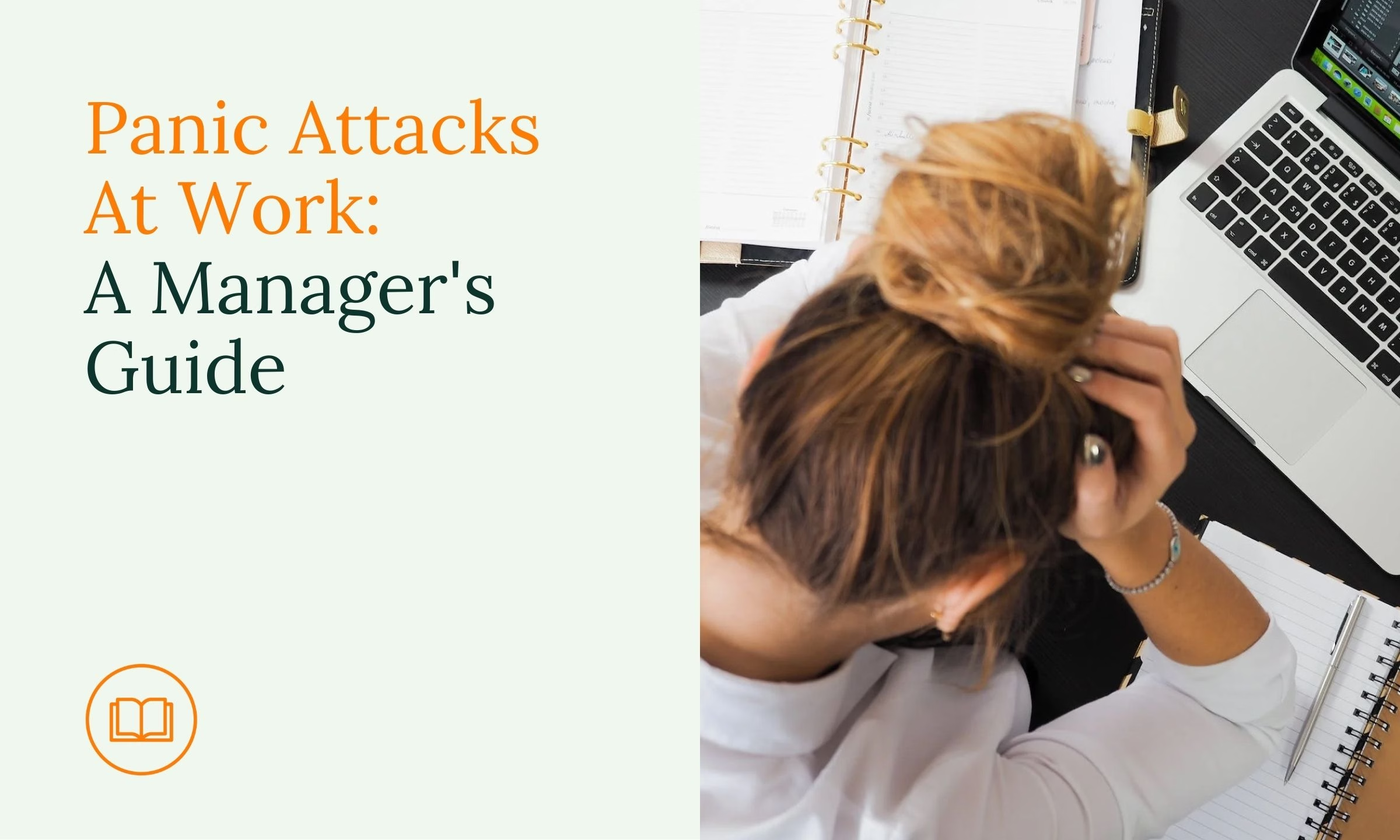Watching or experiencing a panic attack at work might feel scary and overwhelming. It’s an intensely physical reaction to mental anxiety and stress, and it can be confronting. But knowledge is power! Managing panic attacks at work is part of a manager’s responsibility to the health, well-being and performance of their team, so in this guide, we’ll give you all the information you need to steer your ship to calmer waters.

What is a panic attack?
A panic attack is a sudden onset of intense fear or discomfort that can cause physical symptoms such as chest pain, sweating, shaking, and difficulty breathing. Panic attacks might occur unexpectedly and without any apparent trigger, or they can be brought on by specific situations or triggers. The symptoms of a panic attack typically peak within 10 minutes, but a panic attack can last for up to an hour.
Panic attacks are relatively common, with approximately 2-3% of adults experiencing them at some point in their lives, and they’re slightly more prevalent amongst women than men. They often begin in late adolescence or early adulthood, but can occur at any age.
Panic attacks are a symptom of panic disorder, but can also occur in other anxiety disorders, including generalized anxiety disorder and social anxiety disorder. A wide range of factors can trigger a panic attack, including stress, anxiety, caffeine, alcohol, and certain medications.
There are lots of treatment methods for panic attacks out there, including various forms of therapy, such as cognitive-behavioral therapy (CBT), and medication, such as selective serotonin reuptake inhibitors (SSRIs) and benzodiazepines.
What are the symptoms of a panic attack?
A panic attack is a sudden onset of intense fear or discomfort that reaches its peak within minutes, typically around ten minutes. During this time, four (or more) of the following symptoms may occur:
- Heart palpitations, a pounding heart, or accelerated heart rate
- Sweating
- Trembling or shaking
- Sensations of shortness of breath
- Feeling of choking
- Chest pain or discomfort
- Nausea or abdominal distress
- Dizziness, unsteadiness, light-headedness, or faintness
- Chills or hot flashes
- Paresthesias (numbness or tingling sensations)
- Derealization (feelings of unreality) or depersonalization (feeling detached from oneself)
- Fear of losing control or “going crazy”
- Fear of dying
Note: The sudden onset of symptoms can occur from a calm state or a state of heightened anxiety.
Better understanding panic attacks: What really happens in our brain and body
When experiencing a panic attack, we often believe we are dying or losing our mind. When our brain switches to protection mode, it convinces us that something terrible is happening—but this is usually far from the truth.
Our autonomic nervous system responds to perceived threats by triggering physical reactions to protect us. This “fight-or-flight mode” is now often expanded to include “freeze,” as some animals play dead to escape predators.
The nervous system activates specific responses: an increased heart rate prepares us to flee, a narrowed field of vision helps us focus, and our arms and legs feel ready to fight. In the case of freezing, the body simulates a protective response through passivity.
Biologically, the body releases adrenaline in dangerous situations to respond effectively. Once the threat passes, these levels return to normal. However, in cases of chronic anxiety and stress, the body remains in a constant state of alert—even without a real danger.
Why might someone have panic attacks at work?
There are lots of potential triggers for a panic attack in a working environment. Here are some to keep in mind:
- Stressful work environment: A high-pressure work environment, tight deadlines, or a job with a high level of responsibility can be extremely stressful and may trigger a panic attack in some individuals.
- Personal issues: Personal problems such as financial difficulties, relationship issues, or health concerns can spill over into the workplace and trigger a panic attack.
- Social anxiety: People with social anxiety may feel overwhelmed in work situations that involve interacting with colleagues or presenting in front of others.
- Trauma: Individuals who have experienced a traumatic event such as a workplace accident, bullying or harassment, may be triggered by reminders of the event.
Remember, panic attacks can be frightening and overwhelming for both the individual experiencing the attack and those around them. Providing support and understanding helps the person feel more secure and prevents the situation from escalating.
It’s important to note that panic attacks can also be unpredictable and may not have an obvious trigger. However, understanding potential triggers helps managers create a work environment that is supportive of employees and helps prevent or manage panic attacks.
How can I help someone having a panic attack?
What can you do if a team member is facing mental health issues at work? If you are present when someone is having a panic attack, there are a few things you can do to help:
- Stay calm: It’s important to remain calm and composed when someone is having a panic attack. This will help the person feel more secure and can prevent the situation from escalating.
- Provide reassurance: Panic attacks can be scary, and individuals may feel like they are losing control or are in danger. You can help by providing reassurance that they are safe and that the panic attack will pass.
- Encourage slow breathing: Slow, deep breathing can help to calm the body and reduce the severity of a panic attack. Encourage the person to take slow, deep breaths and count along with them.
- Offer a quiet space: If possible, offer a quiet space where the person can sit down and relax. Turn off any music or other background noise that might be adding to their stress.
- Respect their space: It’s important to respect the person’s space and not touch them unless they ask for physical support. This helps them feel more in control of the situation.
Panic attacks can affect everyone, including managers!
Remember, panic attacks can be frightening and overwhelming for both the individual experiencing the attack and those around them. Providing support and understanding helps the person feel more secure and prevents the situation from escalating.
What should I do if I’m the one having a panic attack?
Panic attacks affect everyone, including managers! If you are having a panic attack, there are several things you can do to help manage your symptoms:
- Focus on your breathing: Take slow, deep breaths in through your nose and out through your mouth. This can help slow down your heart rate and reduce feelings of panic.
- Practice grounding techniques: Try to focus on your surroundings and use your senses to ground yourself. Look around and name five things you can see, four things you can touch, three things you can hear, two things you can smell, and one thing you can taste.
- Challenge your thoughts: Panic attacks can often be triggered by negative or catastrophic thinking. Try to challenge these thoughts by asking yourself if they are based in reality or if there is evidence to support them.
- Use coping strategies: Everyone is different, but finding coping strategies that work for you can be helpful in managing panic attacks. Some people find exercise, meditation, or talking to a therapist to be helpful.
- Seek professional help: If you are experiencing frequent panic attacks or if they are significantly impacting your daily life, it may be helpful to seek professional help from a therapist or doctor.
Remember that it is important to be kind to yourself and to not blame yourself for having a panic attack. They are a natural response to stress and anxiety, and with the right support and tools, you can overcome them.
There are several steps that managers and organizations can take to prevent panic attacks at work.
What should I do after someone I manage has had a panic attack?
Support and reassurance are crucial. Here are some steps you can take:
- Check in with the person: Once the panic attack has subsided, check in with the person to see how they’re feeling. Ask if there’s anything you can do to help them feel more comfortable.
- Respect their privacy: It’s important to respect the person’s privacy and not share any personal details with other employees. If the person feels comfortable sharing with the team, they can do so themselves.
- Provide resources: Provide the person with resources for mental health support, such as an employee assistance program or a mental health platform. Encourage them to seek professional help if needed.
- Offer accommodations: Work with the person to identify any accommodations that can help them feel more comfortable at work, such as a quieter workspace or flexible scheduling.
- Follow up: Check in with the person periodically to see how they’re doing and if they need any further support. Let them know that you’re there for them and willing to help in any way you can.
Remember that everyone experiences panic attacks differently and may need different types of support. It’s important to be understanding and flexible in your approach.
How can I prevent people from having panic attacks at work?
There are several steps that managers and organizations can take to prevent panic attacks at work, including:
- Create a psychologically safe work environment: A supportive work environment where employees feel safe to talk about their concerns and receive the necessary support reduces the likelihood of panic attacks occurring.
- Provide resources for stress management: Providing resources such as employee mental health benefits, mental health resources, and stress management workshops help employees better manage their stress levels and reduce the risk of panic attacks.
- Offer flexible work arrangements: Flexible work arrangements, such as remote work or flexible schedules, helps employees better manage their work-life balance and reduce stress levels.
- Communicate clearly: Clear communication with employees about expectations, feedback, and changes in the workplace reduces stress and anxiety levels.
- Provide training and support: Managers can provide training and support to help employees develop coping skills and stress management techniques.
By implementing these strategies, managers and organizations can create a supportive work environment that promotes employee well-being and reduces the risk of panic attacks at work.
Still need support? nilo supports your entire workforce, providing employees with crucial mental health care and reducing the risk and rate of panic attacks at work. If you want to create a healthy and psychologically safe workplace, we’re your first step. Book a demo today!









